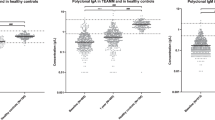Abstract.
Background: This study was undertaken to identify and quantify the class and subclass antibody responses to the culture filtrate antigen (CFA) of Burkholderia pseudomallei in melioidosis patients under long-term maintenance or eradication therapy.
Materials and Methods: Sequential sera samples from seven melioidosis patients collected between January 1992 and April 1998 were analyzed for immunoglobulin (Ig) types and IgG isotypes by ELISA using B. pseudomallei CFA.
Results: Melioidosis patients generated a strong IgG, IgA and IgM response to the CFA of B. pseudomallei throughout the infection and IgG1 and IgG2 were the predominant IgG istotypes produced. Although high levels of these antibodies were detected in all the seven patients, the IgG, IgG1 and IgG2 antibodies showed a consistent response and good correlation with the clinical history in all cases.
Conclusion: This study suggests that monitoring IgG antibody or IgG1 or IgG2 isotype antibody levels to CFA in patients under maintenance or eradication antibiotic therapy may be useful as a tool to detect the status of infection and as a guideline to determine the duration of maintenance antimicrobial therapy.
Similar content being viewed by others
Author information
Authors and Affiliations
Additional information
Received: February 4, 2002 · Revision accepted: October 6, 2002
C. Vasu (corresponding author)
Rights and permissions
About this article
Cite this article
Vasu, C., Vadivelu, J. & Puthucheary, S. The Humoral Immune Response in Melioidosis Patients during Therapy. Infection 31, 24–30 (2003). https://doi.org/10.1007/s15010-002-3020-2
Issue Date:
DOI: https://doi.org/10.1007/s15010-002-3020-2




